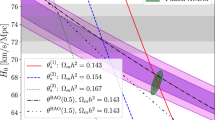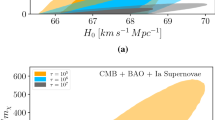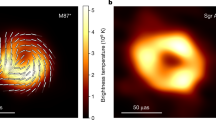Abstract
The matter content of an ever-expanding Friedmann universe will never become negligible compared with the radiation, assuming electrons and positrons (e±s) are absolutely stable, even if all other massive particles are unstable. The possible annihilation of e±s in a k = 0 model occurs so slowly that the radiation density can never greatly exceed the matter density. For a very homogeneous distribution of e±s which cool at just the expansion rate, the asymptotic ratio of matter to radiation density in a k = 0 universe is calculated here to be (√105−3)/12 = 0.6039. Heating by collisional recombination would probably keep the matter density far higher. A certain amount of clumping might make the annihilation occur faster, but larger inhomogeneities are likely to lead to black holes which could be even more effective in keeping the universe from becoming radiation dominated.
This is a preview of subscription content, access via your institution
Access options
Subscribe to this journal
Receive 51 print issues and online access
$199.00 per year
only $3.90 per issue
Buy this article
- Purchase on Springer Link
- Instant access to full article PDF
Prices may be subject to local taxes which are calculated during checkout
Similar content being viewed by others
References
Davies, P. C. W. Mon. Not. R. astr. Soc. 161, 1–5 (1973).
Islam, J. N. Q. Jl R. astr. Soc. 18, 3–8 (1977); Sky Telescope 57, 13–18 (1979).
Barrow, J. D. & Tipler, F. J. Nature 276, 453–459 (1978).
Dyson, F. J. Rev. mod. Phys. 51, 447–460 (1979).
Pati, J. C. & Salam, A. Phys. Rev. D8, 1240–1251 (1973); Phys. Rev. Lett. 31, 661–664 (1973).
Georgi, H. & Glashow, S. L. Phys. Rev. Lett. 32, 438–441 (1974).
Georgi, H., Quinn, H. R. & Weinberg, S. Phys. Rev. Lett. 33, 451–454 (1974).
Zel'dovich, Ya. B. Phys. Lett. 59A, 254 (1976); Soviet Phys. JETP 45, 9–11 (1977).
Hawking, S. W. Nature 248, 30–31 (1974); Commun. Math. Phys. 43, 199–220 (1975).
Bransden, B. H. Case Studies in Atomic Collision I (eds McDaniel, E. W. & McDowell, M. R. C.) (North-Holland, Amsterdam, 1969).
Kramers, H. A. Phil. Mag. 46, 836–871 (1923).
Thomson, J. J. Phil. Mag. 23, 449–457 (1912).
Percival, I. C. & Richards, D. Adv. atom. molec. Phys. 11, 1–82 (1975).
Carr, B. J. Astrophys. J. 201, 1–19 (1975).
Page, D. N. Phys. Rev. D16, 2402–2411 (1977).
Page, D. N. & McKee, M. R. Preprint (Pennsylvania State University, (1980).
Author information
Authors and Affiliations
Rights and permissions
About this article
Cite this article
Page, D., McKee, M. Eternity matters. Nature 291, 44–45 (1981). https://doi.org/10.1038/291044a0
Received:
Accepted:
Issue Date:
DOI: https://doi.org/10.1038/291044a0
Comments
By submitting a comment you agree to abide by our Terms and Community Guidelines. If you find something abusive or that does not comply with our terms or guidelines please flag it as inappropriate.



